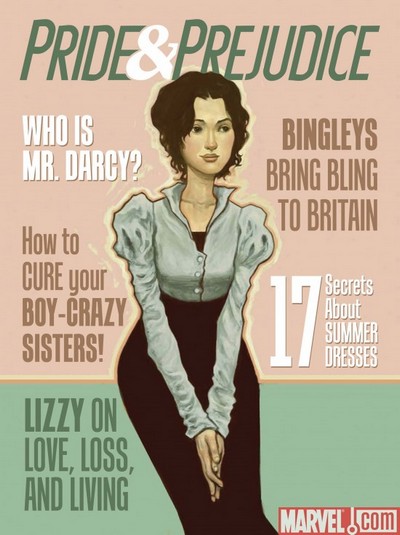Pride and Prejudice
Reviewed by Will Morgan 15-Nov-10
It is a truth universally acknowledged in the United Kingdom that our American cousins, unencumbered as they are by a great deal of history, (my local pharmacist having existed for almost as long as the United States) tend not to fully apprehend historical requirements in reinterpretations of classic literature.
 WITH ADDITIONAL MATERIAL BY JANE AUSTEN…
WITH ADDITIONAL MATERIAL BY JANE AUSTEN…
It is a truth universally acknowledged in the United Kingdom that our American cousins, unencumbered as they are by a great deal of history, (my local pharmacist having existed for almost as long as the United States) tend not to fully apprehend historical requirements in reinterpretations of classic literature.
It is this reviewer’s pleasant duty, however, to report that in this case our esteemed friends from the colonies have avoided the commonplace pitfalls, such as inadequate research (placing two items of historical clothing from different centuries – a wimple and a bustle – on an otherwise contemporarily-dressed woman, and hoping for the best), and instead produced an appealing, if necessarily truncated, adaptation of Miss Jane Austen’s novel of manners and courtship.
Ms. Nancy Butler has been handed the unenviable task of contracting Austen’s work into a scant five issues, and has risen admirably to the challenge. She introduces and distinguishes the characters deftly, and couches the drama of a succession of static conversations and situations into a variety of angles and scenes that keep the reader’s attention fixed.
In this task, she is admirably assisted by artist Mr. Hugo Petrus, who makes a conscientious, if not always entirely successful, effort at period; he is to be commended for his visual distinction of the male characters, and his portrayal of the egregious Mrs. Bennett, one of the most memorable matchmaking monsters of fiction.
It must be observed, though, that in Mr. Petrus’ portrayal of the younger women, particularly the pivotal Bennett sisters, there seems little to distinguish them aside from their hair colour. This is particularly odd when one remembers that the youngest Bennett sister, Mary, is noted in the book as bookish, intellectual, and outright plain. In Mr. Petrus’ eyes, by contrast, she is, in the modern parlance, ‘a hot babe’ who would scarcely be wasting her time on scholarly pursuits.
A further anomaly is the amount of grinning that occurs. Our heroine, Elizabeth Bennett, is frequently unleashing cover-girl orthodontic beams upon all and sundry. Now, while Mr. Petrus’ research has been painstaking in the physical aspect, the social dimension appears to have been lacking.
In the period of this novel, a closed-mouth smile was the most decorous public expression of pleasure a lady was permitted. This was because of social perceptions of ‘appropriate’ versus ‘vulgar’ behaviour, and because, then, (and now, if our esteemed American friends are to be believed) British dentistry simply would not withstand that amount of scrutiny.
A lady grinning as much as Miss Elizabeth and her sisters are shown would not be received into society, and might be assumed, by gentlemen of her acquaintance, to be inviting intercourse of a more than conversational nature.
Nevertheless, one cannot expect perfection; but one can always be pleasantly surprised. And, pausing only momentarily to commend the ingenious cover by Mr. Sonny Liew, which intrigues and entices the potential reader, while not offending purists with a sense of humour and proportion, I have pleasure in declaring this adaptation – available in hardcover, for one’s study or library, or in a compact paperback, suitable for a lady to carry – to be eminently satisfactory.
Tags: Hugo Petrus, Jane Austen, Marvel, Nancy Butler